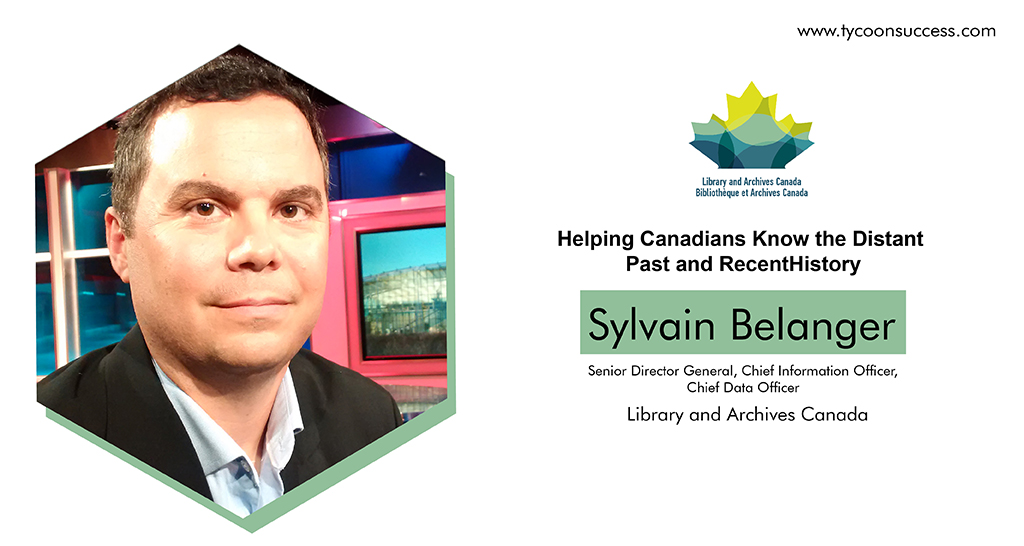Meet Sylvain Bélanger, the Senior Director General, Chief Information Officer, and Chief Data Officer for Library and Archives Canada (LAC), which serves as the guardian of Canada’s distant past and recent history. As the CIO, Sylvain is responsible for leading and supporting LAC’s digital business operations and all aspects of preservation for access of digital and analog collections and digital transformation activities.
Sylvain started his journey at LAC in 2005 as the Chief of Staff to the Librarian and Archivist of Canada. He has also been the Corporate Secretary and Director of Collections Management. He oversaw the business side of digital before 2021 for six years as Director General of the Digital Operations and Preservation Branch. Sylvain was the driving force behind the creation of LAC’s Vision for 2030 during the first two years of the pandemic. Prior to joining LAC, Sylvain worked in several public safety agencies, private sector companies, and the Canadian Forces.
“LAC was a newly created organization from the merger of the national library and national archives. At the time, I saw an opportunity to apply the experience I had gained from my time in public safety and national defense, as well as my education in leadership, to a very different kind of organization that had a history dating to the 1800s, yet was also one of the newest organizations in the government of Canada following the merger of the two organizations,”– Sylvain remembered.
Presently Sylvain serves as the Vice-President of DPI Canada. This volunteer not-for-profit organization promotes the development of public sector professionals and the effective application of IM/IT in the Government of Canada and other public sector jurisdictions. Along with other positions, he has previously held the positions of Vice Chair and Treasurer of the International Internet Preservation Consortium, and is a a member of the IFLA Section on Information Technology.
A Unique Organization
Library and Archives Canada, more commonly known as LAC, is a federal government institution that was created in 2004 by merging the National Library and the National Archives.LAC’s unique collection now contains over 20 million books published in various languages, over 250 linear kilometers of government and private textual records, over three million architectural drawings, plans, and maps, 30 million photographic images, including prints, negatives, slides, and digital photos, more than 90,000 films, more than 550,000 hours of audio and video recordings, over 425,000 works of art, approximately 550,000 items constituting the most extensive collection of Canadian sheet music in the world, and national newspapers from across Canada, from dailies to student and community newspapers.
A Strong Team Culture
LAC has a strong professional culture of experts in the library and archival fields, conservation, information management, mass digitization, as well as digital and analog preservation. Under Sylvain’s leadership, the team has coalesced around its vision and the new digital structure. The key has been creating the proper environment for professional growth, aligning working practices across the lines of business, and having clearly defined purposes and goals that they review and emphasize regularly.
A Socially Responsible Organization
As a federal government institution, LAC always considers its impact on communities and its environmental and social responsibilities. For example, LAC’s new Gatineau 2 storage facility project is a sustainable building with objectives aligned to meet the Government of Canada’s priorities to invest in sustainable federal infrastructure and Canadian culture. It is the first Net Zero Carbon archival center in the Americas. LAC also delivers programs and projects related to First Nations, Inuit, and Métis Nation experiences. This includes funding to support First Nations, Inuit, and Métis Nation organizations throughout Canada to identify, digitize and preserve the Indigenous language and culture recordings, and build digitization and preservation capacity in their communities.
Current Market Trends
Sylvain believes change is inevitable to meet the constantly evolving needs of Canadians. For LAC, this involves enhancing its digital capabilities and gradually altering its in-person and online services to enable Canadians to access their national history from any location. The organization released its Vision 2030 in the spring of 2022, outlining the course for the following eight years and beyond.
Vision 2030: Discover. Understand. Connect. -specifies where LAC wants to go, what it wants to achieve, and how it will get there. The concept is entirely based on inviting users to discover the collections, refining diverse voices, interacting with the community, partnering with the world, supporting Canadians, and preserving their cultural legacy.
Looking at the Future
LAC is committed to using its collections to communicate a range of Canadian cultures and experiences through the most diverse stories, and access will play a pivotal role in this.
“As CIO, I can say that collaboration across LAC, our efforts to modernize and replace our legacy technologies and infrastructure, as well as our work with our colleagues across government, the private and non-profit sectors, and key international partners will be the catalyst for change, continuous improvement, and success for us. My team is building a roadmap that emphasizes our unique needs as Canada’s premiere documentary heritage institution while looking at enterprise-wide solutions with colleagues within the government where it is the most efficient and effective way to deliver our services,”– explained Sylvain.

